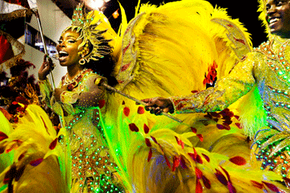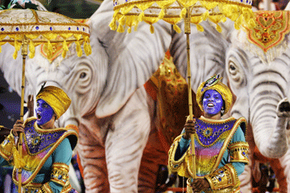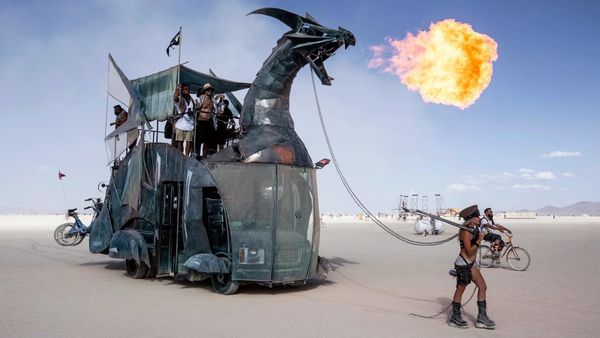Carnaval is a time for abandon, an embrace of Brazilian beauty, sensuality and rhythm. Samba orchestras -- bandas and blocos -- march through Rio, with drunken, dancing revelers in tow. Bandas play the classics. Blocos play something new and different every year. Fans gather at neighborhood bars, waiting for their favorite orchestra to show up and start the marching [source: drag show during Banda de Ipanema draws a huge crowd.
Masquerade balls go on all night, glitzy society ones like the Copacabana Magic Ball, where "luxury masquerade" dress -- intricate costumes that can cost thousands of dollars -- or black-tie is required, and tickets start around two grand [source: Brazil Bookers]. The Rio Scala nightclub balls, including the famously garish Gay Gala, which concludes with a runway show, and the Mangueira Ball, which features a full samba school orchestra and all that goes with it, are more egalitarian parties, with ticket prices in the hundreds [source: Brazil Bookers]. For these, costumes need not be "luxury." They're not even strictly required.
At least one part of the revelry, however, is very serious business: the Samba School Parade. Samba schools aren't actually schools; they're community music groups, made up of musicians and dancers from the same neighborhood. Their show is the main event, and it is a fierce (if joyous and sequin-filled) competition for which samba schools prepare all year.
Over two days in the Sambadrome, at nine hours a stretch, samba schools compete for the champion spot. Each brings an army of thousands, with an orchestra, multiple multistory floats and featured riders, and many required alas, or sections, including drummers, flag bearers, dancers and "whirling ladies," each precisely arranged and dressed alike.
On each float is a "cherry," or star performer, wearing the school's featured costume, which might weigh up to100 pounds (45 kilograms), meaning she's sometimes lifted to her perch via crane. Floats also feature more scantily clad beauties, feathered or glittering, some topless or G-stringed or wearing nothing but artful body paint. Floats may have special effects, like light shows or massive bubble blowers, and many are still pushed along by members of the samba school.
The event is run and judged by Brazil's official samba league, which sets a theme and watches carefully for any missteps -- going over time limit, dancers falling out of sync or sections going off their mark. A winning school is announced on the last night of Carnaval, and the top six schools perform again the following weekend in the winners' parade, also at the Sambadrome.
The Sambadrome fits up to 90,000 spectators, so not all Carnaval partyers can go, although revelers can watch on pretty much any TV in Brazil, or in the 12 other countries that broadcast the festivities in detail [source: Rio Carnival]. International attendees number about 500,000 [source: Rio Carnival].
For those who plan to be among the 500,000, it helps to know the lay of the land before the party starts. Carnaval may be a chance to spend 96 hours in the moment, but tickets for a lot of those moments sell out in advance.


